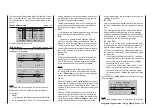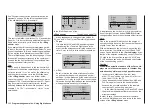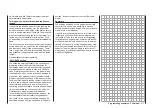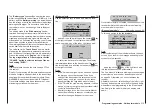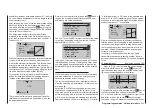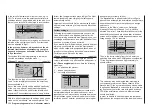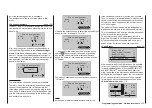
312 Programming examples - Delta and flying wing
not utilize the entire servo travel for the crow alone;
for example:
Elevat curve
Brake settings
AILE
Crow
D.red
+55%
0%
0%
–44%
0%
0%
FLAP FLAP2
Normal
You can ignore all other settings in this menu.
Note:
The “Brake settings” menu is switched “off” if: “Motor
on C1 forward / back” in the »Model type« menu,
page 104, AND the “Motor” column of the »Phase
settings« menu, page 152, are set to “yes” for the
currently active flight phase. Change the flight phase,
if applicable.
Similarly, a modern, tapered flying wing air craft can
also be operated. With some of these models there
are also interior and exterior rudders: The prior is in
front of the center of gravity and the latter is behind.
A downward throw of the central rudder(s) increases
the ascending forces and has an elevator effect. An
upward throw has the opposite effect. On the exte-
rior ailerons, on the other hand, the effect is just the
opposite: A downward throw shows an elevator ef-
fect and vice versa. With appropriate adjustment of
the “leading” mixer to the setting of curve mixers in
order to achieve a supporting effect from the external
rudder pair with only extreme stick deflection in the
height/depth direction, “everything” is possible here.
The author of this manual uses a curve mixer for his
model, which is defined by a total of four points:
0%
0%
Input
Output
Point
C.Mix 9
Curve
EL
5
0%
on
?
In this example the two interpolation points 1 and 2
are each at 0 % as well as the left edge point at +60 %
and the right edge point at -65 %. In conclusion, the
curve was rounded.
In this case: Regardless of which type of servo ar-
rangement was selected, any type of differentiation
should be set with caution! On a tail-less model,
differentiations show a single-sided height/depth
elevator effect, so we urgently recommend beginning
at least the initial flights with a setting of 0 %! Over
the course of the further flight testing, under certain
circumstances it may be advantageous to experiment
with differentiations deviating from zero.
With larger models, rudders in the winglets – the
“ears” mounted on the wing ends – can be beneficial.
If these are controlled with two separate servos, one
of the mixers in the »Dual mixer« menu can be used;
this is available as standard on the
mc-20
HoTT
transmitter only, but can be unlocked on the
mc-16
HoTT transmitter as an extra-cost option. In this menu
…
»Dual mixer«
… the rudder signal can be “split” very easily and
even differentiated, whereby the second rudder servo
is connected to one of the still free receiver outputs.
For a model with a “Delta/fl” tail type, receiver output
“5” should still be unoccupied and it can then be used
as indicated below:
Diff.
Dual mixer
Mixer1
Mixer2
5
RU
Mixer3
Mixer4
??
??
??
??
??
??
0%
0%
0%
+66%
Differentiation is necessary in this case because,
when flying curves, the respective exterior rudders
will have a greater curve radius than the interior rud-
ders, so this is comparable to the front wheel posi-
tions on a car when driving in curves.
Note:
The rudder can only be differentiated as programmed
above!
If these two rudders are also to deflect outward upon
actuation of a brake system with the C1 stick, this
can be achieved, for example, by setting an additional
mixer “C1
5” with an appropriate travel setting. Set
the mixer’s offset according to personal preference,
“front” (+100 %) or “rear” (-100 %), because the wing-
let rudder should deflect outward only for proportional
extension.
Independent of this, finish up by uncoupling the “false”
control function from the control channel to which
the second servo was connected – even though all
inputs in the »Control adjust« menu are “free” by
default – or shift into the menu …
»Mix-only channel«
… which applies to all flight phases, and is available
as standard on the
mc-20
HoTT transmitter only,
in the interests of safety. In keeping with the above
example, control channel 5 should therefore be set to
“MIX only”.
Summary of Contents for HoTT MC-16 Series
Page 1: ...Programming Manual mc 16 mc 20 HoTT 1 en mc 16 mc 20...
Page 27: ...27 For your notes...
Page 53: ...53 For your notes...
Page 61: ...61 For your notes...
Page 65: ...65 For your notes...
Page 71: ...71 For your notes...
Page 103: ...103 For your notes...
Page 107: ...107 For your notes...
Page 111: ...111 For your notes...
Page 155: ...155 For your notes...
Page 165: ...165 For your notes...
Page 201: ...201 For your notes...
Page 229: ...229 For your notes...
Page 231: ...231 For your notes...
Page 261: ...261 For your notes...
Page 265: ...265 For your notes...
Page 301: ...301 For your notes...
Page 327: ...327 For your notes...
Page 328: ...328 For your notes...






